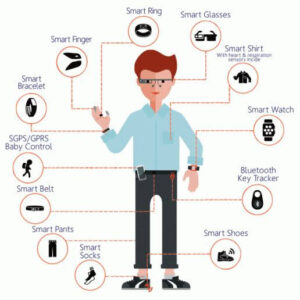Wearable technology refers to a category of electronic devices that can be worn on the body as accessories or embedded in clothing, jewelry, or other items. These devices are typically designed to be both functional and fashionable, and they can provide a range of features and benefits to the user.
These devices often contain sensors that can track various aspects of the user’s health and fitness, such as heart rate, activity level, and sleep patterns. They can also provide notifications for incoming messages, phone calls, and other alerts, and some devices can even allow for voice or gesture-based control.
Types of Wearable Technology

There are many different types of wearable technology and each are designed to serve a specific purpose and provide unique benefits to the user.
Smartwatches: These are wrist-worn devices that connect to a user’s smartphone or other mobile device, and provide features like notifications, messaging, fitness tracking, and even mobile payments.
7 of the best smartwatches to get in 2023
Fitness trackers: These devices are designed specifically to track physical activity, including steps taken, calories burned, and distance traveled. They often include heart rate monitors and can provide feedback and recommendations to help users meet their fitness goals.
Smart clothing: This category of wearable technology includes clothing items like shirts, pants, and jackets that are embedded with sensors to track various aspects of the user’s health and activity level. Smart clothing can monitor things like posture, breathing, and muscle activity, and can provide feedback and recommendations to improve overall health and well-being.
Smart glasses: These are wearable devices that resemble regular eyeglasses, but include features like augmented reality, voice assistants, and even cameras for taking photos or recording video.
Smart jewelry: This type of wearable technology includes items like bracelets, necklaces, and rings that are embedded with sensors and other electronics to provide features like fitness tracking, mobile payments, and notifications and other information.
Head-mounted displays: These devices include virtual reality headsets and augmented reality glasses, and are designed to provide immersive, interactive experiences for gaming, education, and other applications.
Medical wearables: These devices are designed to monitor and track specific health conditions, such as blood sugar levels, heart rate, and oxygen levels, and can provide alerts and feedback to help manage these conditions.
Advantages of Wearable Technology
Environmental monitoring: Some wearable technology devices, such as smartwatches and fitness trackers, can be used to monitor environmental conditions like air quality and UV radiation levels. This information can help people make more environmentally conscious decisions, such as avoiding outdoor activities during times of high pollution.
Resource conservation: It can help individuals track their resource consumption, such as water and energy usage. This data can help people become more aware of their resource consumption and make changes to reduce their environmental impact.
Sustainable materials: Many wearable technology companies are exploring the use of sustainable and eco-friendly materials in their products, such as recycled plastics and organic cotton. This can help reduce the environmental impact of the manufacturing process and reduce waste.
Efficiency: It helps increase efficiency in a variety of industries, such as transportation and energy production. For example, smart sensors can be used to monitor and optimize energy usage.
Remote monitoring: It enables remote monitoring of environmental conditions, such as monitoring water quality in remote locations or tracking the migration patterns of animals. This can help researchers and conservationists better understand and protect the environment.
Disadvantages of Wearable Technology to the Environment
Electronic waste: The devices can contribute to electronic waste, which can be harmful to the environment. When these devices are no longer usable or needed, they can end up in landfills, where their components may release toxins into the environment.
Energy consumption: Many of these devices require batteries to function, and the manufacturing and disposal of these batteries can contribute to environmental damage.
Manufacturing: The production of wearable technology devices can be energy-intensive and contribute to greenhouse gas emissions. Some of the materials used to manufacture these devices can also be environmentally damaging, such as rare earth minerals.
Water usage: The production of wearable technology devices can require large amounts of water, particularly in the manufacturing of textiles and other wearable components. This can contribute to water scarcity and pollution.
Transportation: Wearable technology devices are often manufactured and shipped around the world, which can contribute to greenhouse gas emissions from transportation.

